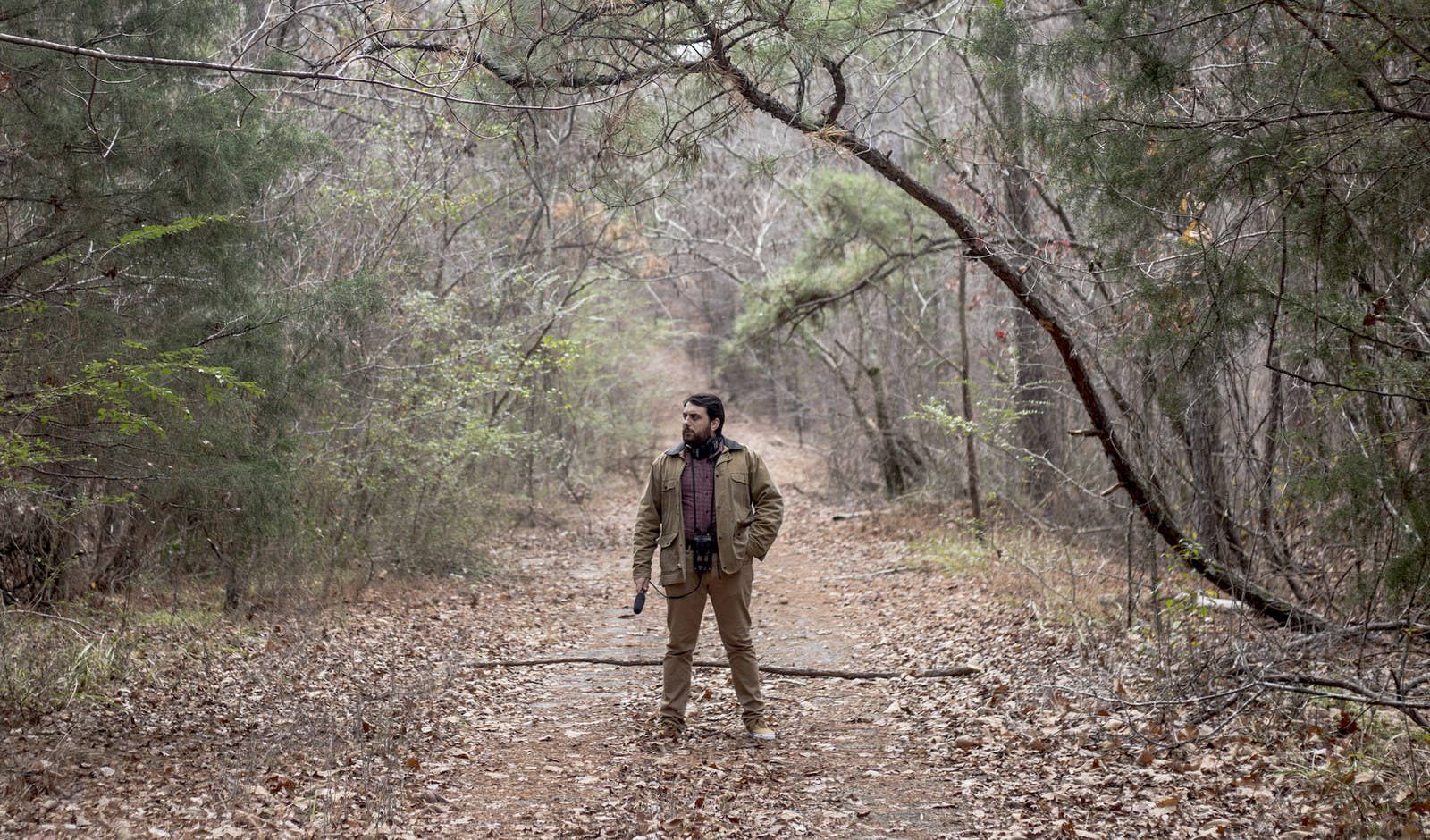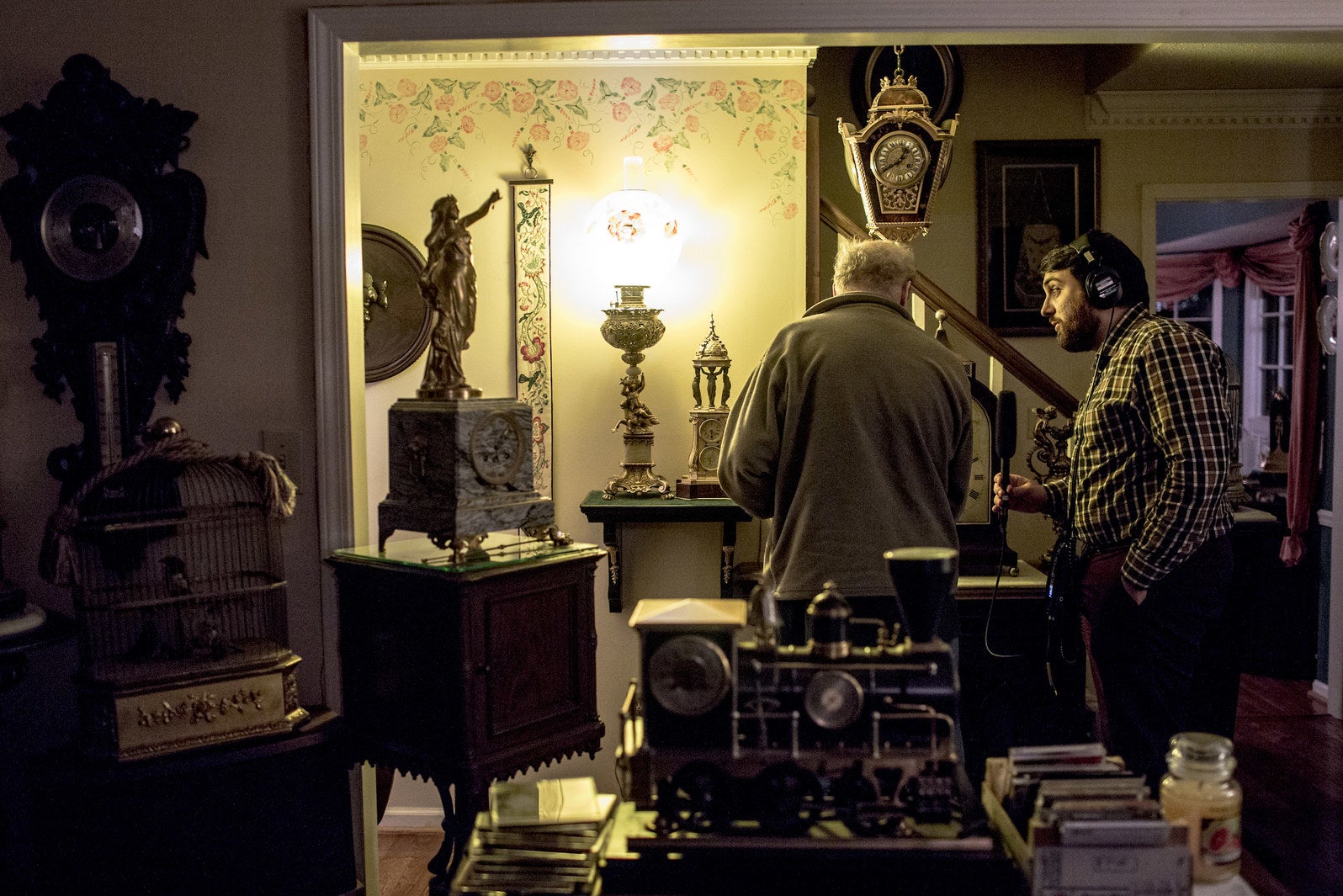
S-Town — the podcast also known by the uncensored title Shittown — has captured listeners’ imaginations, and dominated the iTunes charts, due to its astonishing strengths: the deftness of its prose, the complexity of its pacing, and its humane, clear-eyed treatment of its characters. As assembled into seven chapters by reporter Brian Reed of This American Life and executive producer Julie Snyder of Serial, the show starts out in true-crime territory similar to the first season of Serial: Reed heads to the tiny Alabama town of Woodstock to investigate a possible murder at the behest of one of its residents, John B. McLemore.
The podcast, however, ends up exploring far less familiar terrain. (Warning: This story contains MAJOR SPOILERS for anyone who has not finished S-Town.) For one, Reed discovers that the murder he’s investigating never happened. For another, McLemore asserts himself as S-Town’s true subject — an essentially retired antique clock restorer, the 49-year-old emerges as a one-of-a-kind Deep South eccentric with an inexhaustible intellectual curiosity and fits of profane disquisition. As an example, after just a few minutes in his first conversation with Reed, McLemore rattled off the exact GPS coordinates for a hedge maze he created on his property from memory. Later, he said that as a teenager he was into “the astrolabe, sundials, projective geometry, new wave music, climate change, and how to solve Rubik's cubes,” before launching into a rant about “the cool Greenland melt falling directly into the less dense water where the thermohaline convector normally heads back south…”
S-Town really comes into its own at the end of Chapter II, when Reed gets a shocking call from one of McLemore’s friends, informing him that McLemore killed himself two days prior, by ingesting cyanide. For the rest of the podcast, Reed pursues the fallout from McLemore's suicide, and S-Town transforms into an intimate and sprawling portrait of the man, the people who knew him best, and the community that shaped his life — a community that so repulsed McLemore, he gave it the name that Reed then adopted for the title of the podcast. With all seven episodes released at the same time, the result feels like the first podcast that unfolds like a piece of audio literature, with the storytelling care and humane complexity of works of narrative nonfiction like Truman Capote’s In Cold Blood or Jon Krakauer’s Into the Wild. Listening to it is like witnessing the invention of a stirring and sublime work of art.
Reed and Snyder spoke with BuzzFeed News about how the show came together, and how they navigated the many burning questions listeners were certain to have after finishing it.

McLemore's death almost meant the death of the project.
After McLemore killed himself on June 22, 2015, Reed was unsure that his reporting in Woodstock would ever amount to a story, let alone a seven-part podcast.
"I wanted to just go to his funeral," Reed said. "We weren't sure what to do. … I was doing many other stories during the time I was talking to John, and [S-Town] was kind of something I would do when I had time, on the side."
At This American Life, Reed explained, roughly half of the stories staffers pursue ultimately get killed, and his journey with McLemore might have gone that direction. "What happened after he died is that at least two reporting threads presented themselves to us," Reed said. "I legitimately had questions about this man's life. There were people who seemed to know him well who weren't contacted [after he died]. And then also, the people I did know who were close to him were telling me that there was something nefarious going on in the wake of his suicide, and were keeping in touch with me about it. That seemed like something very clear to report on and document."

S-Town’s novelistic storytelling style was shaped out of necessity: For the story to work in audio, listeners needed to assume it was a fully formed narrative.
Reed estimated that he spoke with "two or three dozen" people for over a year after McLemore died, through interviews conducted on the record, on background, and off the record. He is unsure of the precise number of hours of recordings he amassed in total. "A hundred?" he said after a long pause. "More than a hundred? I really don't know, honestly! I try not to think about it that way, because it overwhelms my mind."
To make sense of it all, he and Snyder created a massive spreadsheet that organized all the interviews and what was said in them before they started piecing together the structure for the show. And that’s when they began to understand that S-Town wasn’t anything like a typical radio story. "There isn't a totally clear question that [Reed] set out with at the beginning, which is generally how I would say 98% of This American Life stories are structured," said Snyder.
Without a central question, they knew the podcast would have to be, at least in part, a profile of McLemore — a format Snyder called "really anathema to radio" due to its lack of a strong forward-motion narrative. "For those reasons, I felt like it's important for it to feel that Brian has a story to bring you, and you're going to have to trust that he knows the beginning, the middle, and the end of this story," she said. "I felt like that's what you get when you read a novel. You open the first page, you have no idea where you are and why you're there, but you have a confidence that you know you can physically see there's a final page, and the author has a story to tell you."

Reed added that the very nature of his reporting — especially "the metaphors that John was handing me" in their interviews — leant itself to a literary approach. "He's a horologist," he said. "He's got a giant maze in his backyard with 64 different solutions and one with no way out. 'Shittown' as a concept even seems literary — the very multifaceted way in which he employed that word. And it seemed to encapsulate not only his town but much larger ideas about the failures in society, statewide, nationally, globally."
The sheer length of time Reed took to report the story even ended up contributing to the podcast's novelistic appeal. "We realized when we sat down to structure it that I'd accidentally given myself the power of omniscience, in a way, and of foreshadowing," said Reed. "We'd be talking about a scene that happened a year and a half ago, that we're putting in the story, and I knew something from the future about that person, or that scene. People have literally died and been born in the time that I've been around the people in Woodstock."

Reed rigorously chased down every lead for the story, even if the end result didn't ultimately answer all the questions he raised on the show.
The style of S-Town also sets the podcast apart as a piece of journalism: Many of the concrete questions Reed explored — like the location of McLemore's purported stash of gold, or the reason behind why many of McLemore's friends didn’t learn about his death until after his funeral — remain unresolved by the show's end.
"I mean, I wanted to answer them, and I did my best in reporting them, and presented my best findings," said Reed.
Snyder also stressed that S-Town relied on time-honored best practices of journalism — checking and rechecking facts, tracking down interviews, finding documentation, etc. — even if that wasn't always apparent in the way they presented Reed's reporting, given the conversational tone of the show. "The idea is that maybe the reporting is kind of a little easy-breezy also," she said, causing Reed to laugh. "What makes up the story is really very traditional, unglamorous, kind of sloggy reporting."
“When we’re making a story, for a large part we’re making it for ourselves and our own taste.”
(One thing they didn’t stress: getting photos of McLemore or anyone else from S-Town for the podcast's website, which has almost no photos at all. "I hate pictures," Snyder said with a laugh. "I'm highly opposed to pictures with radio stories. I don't know if I'll always think that's true, but 93% of the time, I will always say no pictures. That's what the internet's for.")
Ultimately, however, the more traditional journalism that propels This American Life and Serial, driven by seeking conclusive answers to explicit questions, just didn't apply to S-Town — and that was fine with its makers. "For Julie and me, those aren't the things that interest us most about the story," said Reed. "When we're making a story, for a large part we're making it for ourselves and our own taste. And in that regard, it would have been cool to be able to report some of that stuff out further than I did. But it wasn't terribly upsetting to us."

...So don't ask about what happened to McLemore's gold.
S-Town’s final chapter includes a moment from early on in Reed's reporting when he spoke with McLemore's quasi-surrogate son Tyler Goodson, another of the story’s central characters. His life was upended the most by McLemore's death, in part due to his efforts to collect items from McLemore’s property that he claimed were his. Due to the legal dispute over who owned the land and everything on it, Reed counseled Goodson about revealing on the record whether he'd found the cache of gold McLemore hinted he’d hidden on his property.
"Well, listen, I clearly want to know if you ever do find it. But you should think about it before you tell me, if you ever do, because it's then going to be public," Reed tells Goodson on the show.
"Yeah, I know. That's what I'm scared of now," Goodson replies.
"I would worry if you found a million dollars in gold, or if you found, like, a bunch of gold," says Reed. "Just consider it before you ever tell me, all right?"
After a pause, Goodson asks Reed to turn off his recorder, and Reed, in voiceover, explains that they'd had "a discussion off the record."

That is the last we hear about McLemore's gold on S-Town — and that's where Reed wants to leave it, at least for now. "I've really said as much as I feel comfortable saying in the show itself," he said.
Reed also pushed back at the suggestion that placing that conversation at the end of the show might leave listeners with the impression that Goodson did, indeed, find at least some gold. "Actually, I think if you look online, people are having all sorts of conclusions," said Reed. "That was not our intention."
Reed and Snyder said they only meant to give listeners the most up-to-date information they had on the record about Goodson's legal situation (which, by the way, has not changed since the show went live — he’s is still awaiting trial on several charges). "Also, people in the story speculate that Tyler took the gold, so we did have a responsibility to run the question past him," Snyder said.

Reed did try to interview the Woodstock police and McLemore's mother Mary Grace, but only the latter would speak with him.
One theory on the whereabouts of McLemore's gold is that the Woodstock police could have either made off with it themselves or looked the other way when someone else did. Conspicuously, however, Reed said no police officers would speak with him despite multiple requests for an interview. All he got were written responses to some questions he sent to the town's chief of police, which included the department's denial that they had found any gold on McLemore's property (as Reed noted in Chapter V).
Another voice largely absent from S-Town is McLemore's mother, Mary Grace, whose well-being becomes the first spark of conflict between Goodson and her next of kin, McLemore’s cousin Reta and her husband Charlie. But Reed said he did get a chance to interview Mary Grace on the record after Reta and Charlie brought him to see her. "I saw where she was staying, and she did seem to be doing well," he said. "She was in pretty good spirits. She's very quick-witted, despite her clear dementia, and funny, and kind of biting sometimes."
Reed ultimately chose not to use any of his recorded interviews with Mary Grace in the podcast. "It didn't seem to fit into the story," he said, choosing his words carefully. "It wasn't the most…her faculties are not there in terms of an interview." He did, however, use some of what he learned from Mary Grace. "For instance, the detail I include in the last [chapter] about her rubbing her stomach and praying for a genius," he said. "I had heard that story from someone else she had told it to, but then she told me that multiple times on the record." As far as Reed knows, Mary Grace is still staying with family friends. "The last I heard in the last couple months, she's been thriving and doing well."

Don't worry too much about McLemore's dogs, either.
McLemore kept a small army of stray dogs on his sprawling property, and there was some question as to what would become of them — McLemore had requested that they be euthanized after he killed himself. It turns out, they're almost certainly fine. "For a long time, at least two of them were with Tyler," said Reed. "And then it's my understanding that homes were found for the rest. I don't have the firmest information on this, but to my knowledge, they were not euthanized."

Reed and Snyder adamantly believe it was fair for S-Town to go into detail about McLemore's sexual experiences with other men.
Although S-Town has earned wide critical acclaim, responses to the podcast have not been uniformly positive. A recent Vox essay with the headline "S-Town is a stunning podcast. It probably shouldn't have been made." typifies a lot of the criticism of the show — namely, that Reed went too far in exploring the intimate details of McLemore's romantic and sexual history with other men without McLemore's expressed consent to do so.
It is an argument that frustrates Reed and Snyder. They both note that McLemore outed himself in his second email to This American Life, and was always up front about his sexuality with Reed when he was alive. "I didn't ask him about that, I was asking about a murder. He put it on the table," Reed said.
“I thought it would be very odd to talk about John and not talk about his experience with love.”
Reed and Snyder decided that discussing McLemore’s sexuality was necessary to paint a full portrait of the man and his community. "In terms of the very particular experience of a gay man in his forties who grew up in Alabama in Bibb County, it's unique," said Snyder. "I thought it would be very odd to talk about John and not talk about his experience with love. … I think it's meaningful for a lot of people who had that experience."
Snyder suggested that uneasiness with exploring McLemore's sexuality could have something to do with society’s larger issues with intimacy between two men. She cited a passage in Chapter VI featuring Olin Long, a close confidant of McLemore's who wrestled with his desire for something beyond friendship between them. After reaching out to Reed to inquire about the story, Long was eager to speak to Reed on the record about McLemore; he shared an anecdote about sitting in McLemore's pickup truck with him and experiencing a surge of deep feeling for his friend.
Long tells Reed on the podcast, "I wanted to reach over there, I wanted to pull his shirt up, expose his belly, and just kiss all over his belly around that red hair, just to that extent. And I wanted to do it slowly and sensuously. That's what I wanted to do, and see what he thought about it."
"It's incredibly intimate, when Olin talks about what could have been,” Snyder said. “Brian knows, I would squirm [listening to it]. I would be totally like, 'Oh god, where's he going?'" She compared it to her reaction to watching the beach scene in the film Moonlight during which two teenage boys have a sexual encounter. "I totally squirmed then, too. I think there's a bit of homophobia in squirming at that intimacy. I recognized it in myself when I saw Moonlight, and I recognized it in Olin's talking about John."

Similarly, Reed and Snyder also believe that McLemore's "church" experiences with Goodson were fair game for inclusion.
S-Town also explores another complex form of intimacy, which McLemore shared with Goodson, a straight man in his mid-twenties, in a ritual the two men referred to as "church": Goodson would run a tattoo gun over McLemore’s body, over and over again, often without any ink, to inflict a kind of targeted pain. The Vox piece criticized Reed for not correctly characterizing "church" as the BDSM practice of "needle play," something Reed takes strong issue with.
"I could never do that because that's not how Tyler characterizes it," Reed said. "That would be me imposing a thing onto the person who actually partook in it. I'm open to the idea that these are complicated activities that can mean many things at once. But the way that it was described to me by Tyler is that it helped [McLemore] relieve his pain. It helped him be able to sleep at night. It cleared his mind of his worries, which is similar to cutting, and we checked with a social worker, and they agreed."
Reed felt that he was justified in including these details about "church" because they involved Goodson just as much as they involved McLemore. "Tyler talked to me about it many times. It was something he was dealing with in the wake of John's death." He’d heard multiple people in Woodstock say that Goodson was a bad influence on McLemore, but Goodson said McLemore was the one pleading with him to do "church" every night, Reed said. "I thought it helped give a much fuller and more complicated picture of their relationship at the end. We were very judicious about what we did include. There was much more that we did not. ... We tried to treat it with as much care as possible."

Reed and Snyder didn't think about S-Town’s connection to Trump voters until after the election.
According to Reed, McLemore never really expressed much of a political opinion beyond his low opinion of politics in general. "He thinks of the Democratic and Republican parties as twin cheeks on the same ass," Reed said. "But we didn't delve much deeper than that."
McLemore died a week after Donald Trump formally announced that he was running for president in 2015; as the rest of the media world scrambled to understand Trump voters the next year, Reed and Snyder had their heads down putting S-Town together. They said they didn't really think about the fact that their show was set among exactly the kind of working-class white voters who made up a big part of Trump's base.
However, Reed did have to personally confront at least one issue wrapped up with some of those supporters: Reed’s wife is black, and many of the people he spoke to for S-Town, including McLemore, held racist attitudes and used racist terms. At a certain point in his reporting, his spouse's race became much harder to keep private.

"With Tyler and his family, I was just spending so much time with them that, like, eventually they wanted to be friends on Facebook," he said. "We talked about the use of certain words. And I told him that they made me uncomfortable. It's a weird position to be in as a journalist, because you don't want people to censor themselves. So that's not what I was trying to do. But I was also trying to be myself, you know? But [Goodson] was fine. Like, it was not an issue. And some of the language did calm down after that, actually."
And then, well into the editing process for S-Town, Trump was elected president. At first, Reed was plunged into despair. "The day after the election, I remember coming in and feeling like, What the hell's the point of this story?" Reed said. "There's all this stuff going on in the world to cover. I want to be back at my normal job where I can do reporting about things that are actually happening now, that are relevant to the world. And then the next day, I remember feeling like, Oh, maybe this is a little bit what the story's about."
After some discussion, S-Town’s connection to the Trump voter didn't really end up changing their approach to the podcast. "I think we just kind of comforted ourselves with that thought," he said, laughing with Snyder. "It was a way to feel OK about why we weren't reporting on the incoming administration and the very surprising election."

Reed and Snyder would love to try to do something like S-Town again, even though they're not actually trying to do something like S-Town again.
S-Town’s popularity has already elicited inquiries about possible movie or TV adaptations. "There's definitely been interest," said Snyder. "I'm very literal, so I have a hard time being like, What would it be, other than just people speaking the lines of the podcast? But it would be cool to see."
Given S-Town’s reception, one might expect Reed, Snyder, and the This American Life and Serial teams to be talking seriously about how to make another podcast that attempts the same narrative style again.
“What makes anything feel new, is that the creators are trying to fend off their own boredom.”
"We're so bad at that," said Snyder. "No. I know, I know. It sounds like I'm being paternalistic when I'm like, ‘No, trust me, you like us better this way.’ If we thought that way, we would have come out of the first season of Serial and looked for another murder story. If anything, we actively move against it."
"I think part of what makes the thing feel new, and what made Serial feel new, and what makes anything feel new, is that the creators are trying to fend off their own boredom,” added Reed. “So to try to recreate this — I don't know."
"I told you that my brother wants us to do Shittown Season 2 in my hometown?" Snyder said to Reed with a laugh. "That's what we joked about, the anthology series of Shittown. We'll just do Shittowns across America."
CORRECTION
Olin Long contacted Brian Reed to ask about his podcast; an earlier version of this story misstated Long's reason. Also, the spelling of the name of John McLemore's cousin Reta has been corrected.
